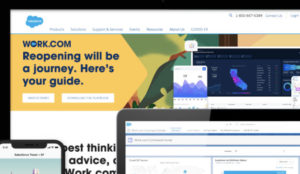The front office is moving out the front door and into the world. Actually, it’s exiting via the Internet, the windows, side doors — and even the smokestack — to form the basis of what will be the next normal, or whatever future historians want to call it. For a while, when we were just dabbling with mobility and social media, we could ignore all that — but no more.
I learned in writing my last book that disruptive innovation is often the necessary but not the sufficient cause of change. Innovations accumulate over a period of years and it takes several of them to congeal into a new idea that spawns an industry, products, and ways of life.
The combination is often the disruption. We’re used to thinking of innovations as things that we make rather than ideas and services but that’s increasingly short-sighted and has been for some time. Things and ideas are hard to separate, but they are analogously the difference between hardware and software.
Was it the availability of MRP, ERP, and other back-office technologies that sparked our modern approaches to business, or was it the somewhat wonkish idea of just-in-time inventory that got us thinking and behaving differently? Certainly, the availability of the technologies told us we could think otherwise.
That’s where we are in the front office right now — and CRM is in the thick of it. The precipitating event isn’t the availability of phenomenal software that enables us to quickly build reliable systems that embody our new ideas and processes but how we think about business.
Stakeholder Capitalism
It starts with the Business Roundtable’s (BRT) 2019 declaration of what’s crystalizing into stakeholder capitalism — a significant departure from shareholder capitalism. Why is this important? Why was just-in-time inventory important? Because it changed everything.
To be brief, the BRT identified a handful of stakeholder constituents, including customers, partners, local communities, and of course, shareholders who can be addressed and benefit by disruption — and those benefits all carry information requirements.
Several years ago, Salesforce introduced its Philanthropy Cloud. It was immediately seen as a one-off extension of CEO Marc Benioff’s passion for giving back to the community. Benioff was also a founder of the Pledge 1% movement, which now has over ten thousand member companies that pledge to give back up to one percent of their equity, profit, employee time, and product to philanthropic causes.
Philanthropy Cloud scratches that itch but it was a weigh station, not a destination because the idea penetrates most aspects of business. The BRT’s pronouncement will change how businesses deal with people, the planet, prosperity and governance. The information needs to be implied are why CRM and its kin are marching out the front door.
Here’s how it all begins to change modern life and business:
People
CRM has always been about people, however, imperfectly, we applied its capabilities. Its bread-and-butter innovations still try to answer questions like “who are my customers, and what do they want?” But CRM technology is equally adaptive to answering the same questions about employees and partners, and increasingly we’re seeing apps for those constituents.
But in the emerging era of stakeholder capitalism, issues of information flow, especially to customers and employees (and especially as they apply to educate everyone), are coming forward. Products like Trailhead, another Salesforce product, provide an online approach to effectively communicating specific information to targeted communities. This isn’t new. Online courses have been around for a while. But what is new is harnessing the paradigm to address the needs of stakeholder capitalism.
Planet
We can’t get away from planet issues, just as we can’t escape our own skins, and in stakeholders, capitalism providing a great product at a great price with great service won’t be enough as the public becomes more aware of the impact of their choices. A renewed emphasis on climate issues is entwined with customer purchase decisions, so businesses are going to need credible stories about their involvement in mitigating the effects of their products across the world.
Planting a trillion trees is an initiative involving multiple non-governmental organizations (NGOs) and CRM-based applications are showing up that help business to track their pollution. This is essential to providing justification to stakeholders for taking action. A trillion trees sounds like a lot, but it’s just a down payment. There will be other solutions and they’ll rely on CRM-based systems to provide justification and reporting.
Prosperity
Don’t think you know this one because it isn’t about profitability, it’s more about the Pledge One Percent thing. It’s about giving back so that prosperity is not limited to a minority that controls everything. In economics, we know that my spending is someone else’s profit, but we don’t always make the connection that to increase our profits, we need to increase others’ spending. The surest path to that outcome is to support more people on the path to becoming fuller economic entities. In other words, this is where philanthropy really kicks in.
Governance
Somebody’s got to manage all this, and it looks like non-financial reporting will become increasingly important just ahead — sustainability, philanthropy, and generally giving back have information needs.
Governance for financial reporting is well understood today and there are systems for that. Non-financial reporting will need to bring a lot of disparate data together, which will require good, fast integration and incisive analytics to pull information from all that data. The information will be critical to justifying a business’s stance on stakeholder capitalism too.
Whose Job Is It?
This brave new world will open up opportunities for new corporate jobs, though to get started, we should expect that stakeholder capitalism will simply add to the plates of the people already in position.
It would be nice to say we need to develop titles like Chief Equality Officer, Chief Sustainability Officer and so on. Several decades ago, we went through a roughly decade-long process of upgrading the director of management information systems (MIS) which reported to the CFO, to a full-fledged CTO reporting to the CEO. So it will take time for the rest of this to jell. Meanwhile, look for the COO, CFO, and General Counsel to take on new non-financial responsibilities.
My Two Bits
CRM’s rapid rise in the front office and beyond relies on its underpinnings: cloud computing, platform technology, integration, and analytics. In some ways, CRM has been the proof of concept for all of this discussion. While stakeholder capitalism has a neo-faddish and lightweight feel right now, it’s worth remembering the derision that software-as-a-service was greeted with for comparison.
New stuff feels funny, but its proof is in how it impacts profits. CRM has always impacted profits by making customer-facing operations less costly and more certain for the vendor. The new iteration of CRM coming into view does the same — but for all of us.



























































